Locomotives of Bangladesh
In the rail transport system of Bangladesh, diesel locomotives are used. Among diesel locos, there are diesel-electric and diesel-hydraulic locos. Besides diesel locos, steam locos were used in the past, but now they are no longer used. By gauge, there are narrow-gauge (762 mm), meter-gauge (1,000 mm) and broad-gauge (1,676 mm) locos in Bangladesh. Among them, as no narrow-gauge railroads are active, so the narrow-gauge locos are not used anymore.
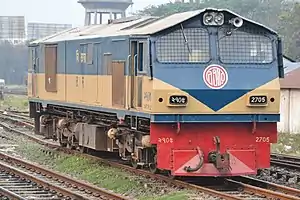
In 1961, there were 415 steam locos (both broad-gauge and meter-gauge) in the then East Pakistan, out of which, 262 were more than 30 years old.[1] Also there were 51 meter-gauge diesel locos, among which, 40 were class 2000 and 11 were class 3000 locos.[1] As of 2020, total 476 meter-gauge and broad-gauge diesel locos (including the old 11 class 3000 locos) have been imported in Bangladesh. Most of them are diesel-electric, but 80 locos are diesel-hydraulic. Among the 476 locos, 349 are meter-gauge and 127 are broad-gauge.[2] All diesel-hydraulic locos were produced by Ganz-MÁVAG of Hungary. Various companies produced the diesel-electric locos, notable among them are GMD, ALCO, MLW, Hyundai Rotem. and BLW, Progress Rail.[3][4][5][6]
History
Rail network started in the then East Bengal of Indian Subcontinent on 15 November 1862.[7] During that time, steam locos were used to pull trains. They served the railway of Bangladesh for the next hundred years (approx.). Diesel locos first started operation in Bangladesh (the then East Pakistan) with the introduction of class 2000 EMD B12 diesel-electric locos in 1953.[8][9] Till then, the demand and usage of diesel locos increased rapidly. Side by side, the usage of steam locos decreased, and in 1980s, all steam locos were taken out from service. A small number of them are preserved.[10]
Classification and numbering
All steam locos were classified according to the Indian Railways' classification system. In case of diesel locos, a class name having three letters and two digit number is given according to the present classification system of Bangladesh Railway.
First letter denotes the track gauge the loco is operated.
- B = Broad–gauge
- M = Meter–gauge
Second letter denotes type of diesel traction.
- E = Diesel–electric
- H = Diesel–hydraulic
Third letter denotes first or last letter of the name of manufacturer.
- A = American Locomotive Company (ALCO)
- B = Bombardier
- D = Diesel Locomotive Works (DLW)
- E = English Electric
- G = General Motors Diesel (GMD)
- H = Hitachi
- I = Hyndai Rotem
- L = Henschel
- M = Montreal Locomotive Works (MLW)
- P = Progress Rail
- Z = Ganz–MÁVAG
Two digit number denotes the approximate power × 100 of the locomotive in horsepower unit.
For example: MEG-15. Here, M = Meter-gauge, E = Diesel-electric, G = General Motors Diesel, and 15 = 15 × 100 hp = 1,500 hp.
A number series is given to each loco class and all locos of that class are numbered according to that series. For example: There are 13 locos from BED-26 class. The preferred series for that class is 6400 and the 13 locos are numbered from 6401 to 6413. In some cases, class is called specification and series is called class instead.
There are some exceptions to this rule. For example: The 40 locos of MEG-11 class are numbered from 2000 to 2039 instead of from 2001 to 2040 (same case for BEA-20 class too). BED-30 and BED-33, despite being different loco class, have the same series (6500 series). 2300 and 2400 series locos belong to same class, MEM-14. There used to run some shunting locos in Bangladesh in the 1960's having the 3000 series (currently withdrawn). So, the 10 new Hyndai Rotem locos from South Korea should be given the 3400 series (as 3100, 3200 and 3300 series are also already used). But instead of 3400 series, they were given the 3000 series. As of 2020, no locos from 2100, 3000 (old), 3100, 6200 and 7000 series are active.
Steam locomotives
| Gauge
(mm) |
Class | Builder | Build
date |
Total
made |
Whyte
notation |
Length
(m) |
Width
(m) |
Height
(m) |
Weight | Tractive
effort (tonne) |
Locale |
|---|---|---|---|---|---|---|---|---|---|---|---|
| 762 | CB | Vulcan Foundry | ? | ? | 2-4-0T | ? | ? | ? | ? | ? | Khulna-Bagerhat Railway |
| CS | W. G. Bagnall | 1936 | ? | 2-4-0T | 5.689 | 2.286 | 3.2 | 11.76 Tonnes | 2.05 | ||
| 1000 | MAWD | Alco | ? | 86[11] | ? | ? | ? | ? | ? | ? | ? |
| PM | ? | ? | ? | ? | ? | ? | ? | ? | ? | ? | |
| PS | ? | ? | ? | ? | ? | ? | ? | ? | ? | ? | |
| RC | ? | ? | ? | ? | ? | ? | ? | ? | ? | ? | |
| WD | ? | ? | ? | ? | ? | ? | ? | ? | ? | ? | |
| YD | Nippon Saryo | 1952 | 25 (for PER) |
2-8-2 | ? | ? | ? | ? | ? | ? | |
| 1676 | APC | ? | ? | ? | 4-4-2 | ? | ? | ? | ? | ? | ? |
| BTC | ? | ? | ? | 2-6-4T | ? | ? | ? | ? | ? | ? | |
| CWD | Canada | ? | ? | 2-8-2 | ? | ? | ? | ? | ? | ? | |
| HPS | Vulcan Foundry | 1947 | ? | 4-6-0 | 18.98 | 3.2 | 4.11 | Loaded: Loco-76.9 tons; Tender-52 tons Empty: Loco-71.3 tons; Tender-23.96 tons |
? | ? | |
| SGC-Z | Vulcan Foundry | 1921 | ? | 0-6-0 | 16.4216 | 2.731 | 4.017 | 98.48 Ton | 11.76 | Paksey Division (1921–36) Saidpur workshop (1936; For shunting purpose) | |
| SGS | Vulcan Foundry | ? | ? | 0-6-0 | ? | ? | ? | ? | ? | ? | |
| SPS | Vulcan Foundry | ? | ? | 4-4-0 | ? | ? | ? | ? | ? | ? | |
| XB | Vulcan Foundry | 1936 | ? | 4-6-2 | ? | ? | ? | 90.2 long tons | 12.14 | ? | |
Preserved steam locomotives
| Gauge | Class | Loco no. | Build no. | Location | Withdrawn | Image |
|---|---|---|---|---|---|---|
| 762 mm (2 ft 6 in) | CB | 7 | ? | Paksay Railway HQ, Pabna | 1970 |  |
| 8 | 1757 | Pahartali railway workshop, Chittagong | 1969 | 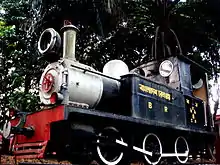 | ||
| CS | 15 | 2539 | Saidpur railway workshop, Nilphamari | ? | ||
| 1,000 mm (3 ft 3 3⁄8 in) | RC | 233 | ? | National Scout Training Center, Mouchak, Gazipur | ? | |
| YD | 718 | ? | Rail Bhaban, Dhaka | 1983 |  | |
| 1,676 mm (5 ft 6 in) | HPS | 30 | ? | Rajshahi Rail Bhaban, Rajshahi | 1984 | 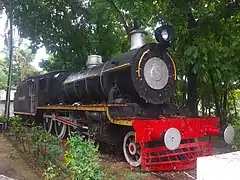 |
| 32 | ? | Eastern Railway Museum, Howrah, India[12] |  | |||
| SGC-Z | 240 | ? | Saidpur railway workshop, Nilphamari | 1983 |  |
Diesel locomotives
Meter-gauge diesel locomotives
| Class
series |
Class
name |
Builder | Model | Nos. | Numbering | First
introduced |
Power
(hp) |
Speed
(km/h) |
Base | Image |
|---|---|---|---|---|---|---|---|---|---|---|
| 2000 | MEG-11 | GMD | B12 | 40 | 2000–2039 | 1953 | 1125 | 100 | CGPY |  |
| 2100 | GEU-14 | GE | UM13C | 10 | 2101–2110 | 1964 | 1420 | 103 | ? | 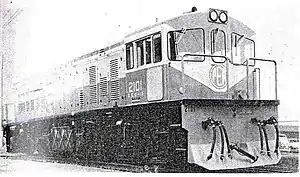 |
| 2200 | MEG-9 | GMD | GL8 | 41 | 2201–2241 | 1961 | 875 | 124 | CGPY Kamalapur Pahartali Parbatipur |
 |
| 2300 | MEM-14 | MLW | DL535A/RSD-30 | 24 | 2301–2324 | 1969 | 1400 | 96 | Kamalapur Parbatipur |
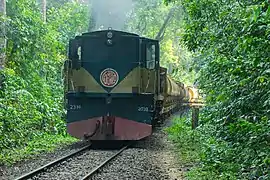 |
| 2400 | 12 | 2401–2412 | 1978 | 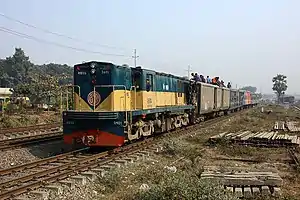 | ||||||
| 2500 | MEH-14 | Hitachi | HFA13A | 18 | 2501–2518 | 1982 | 1400 | 96 | Kamalapur | .jpg.webp) |
| 2600 | MEG-15 | GMD | GT18LA-2 | 16 | 2601–2616 | 1988 | 1500 | 107 | Pahartali | 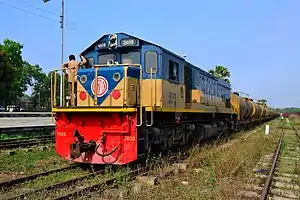 |
| 2700 | MEL-15 | Henschel Adtranz |
JT18U6 | 21 | 2701–2721 | 1994 | 1500 | 107 | Pahartali | .jpg.webp) |
| 2800 | MED-14 | DLW | DL535A/ RSD-30 (YDM 4BR) |
10 | 2801–2810 | 1996 | 1400 | 96 | ? |  |
| 2900 | MEI-15 | Hyundai Hyundai Rotem |
GT18LA-2 | 39 | 2901–2939 | 1999 | 1500 | 107 | Kamalapur Pahartali Parbatipur |
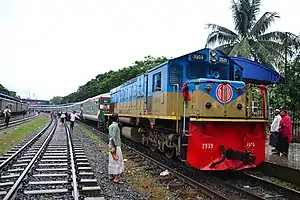 |
| 3000 | ? | ? | ? | 11 | ? | ? | 335 | ? | ? |  |
| MEI-20 | Hyundai Rotem | GT38AC | 10 | 3001–3010 | 2020 | 2200 | 107 | Kamalapur Pahartali |
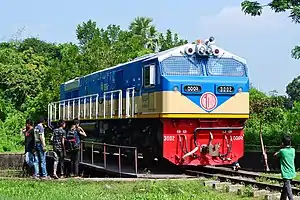 | |
| 3100 | MEE-5 | English Electric | EEU-6 | 26 | 3101–3126 | 1973 | 550 | 56 | Pahartali |  |
| 3200 | MHZ-5 | Ganz-MÁVAG | DHM 10 | 22 | 3201–3222 | 1980 | 590 | 60 | Dewanganj | 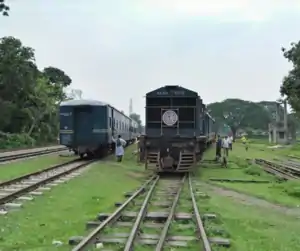 |
| 3300 | MHZ-8 | Ganz-MÁVAG | DHM 12 | 38 | 3301–3338 | 1983 | 800 | 72 | Bonarpara | 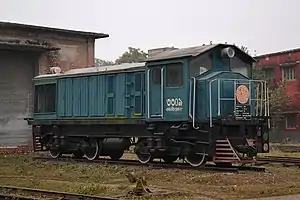 |
Broad-gauge diesel locomotives
| Class
series |
Class
name |
Builder | Model | Nos. | Numbering | First
introduced |
Power
(hp) |
Speed
(km/h) |
Base | Image |
|---|---|---|---|---|---|---|---|---|---|---|
| 6000 | BEA-20 | Alco | DL543/RSD-34 | 18 | 6000–6017 | 1965 | 2000 | 106 | Ishwardi | 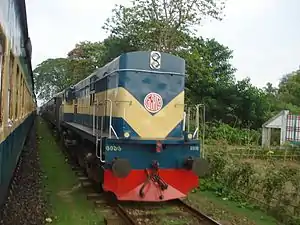 |
| 6100 | BEM-20 | MLW | DL543/RSD-34 | 16 | 6101–6116 | 1969 | 2000 | 106 | Ishwardi |  |
| 6200 | BEH-24 | Hitachi | HFA24A | 12 | 6201–6212 | 1980 | 2450 | ? | Ishwardi | 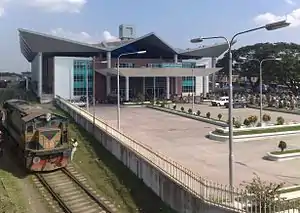 |
| 6300 | BEB-22 | Bombardier | MX 624 | 12 | 6301–6312 | 1980 | 2200 | 105 | Ishwardi |  |
| 6400 | BED-26 | DLW | DL560C (WDM 2B) |
10 | 6401–6410 | 2001 | 2600 | 120 | Ishwardi |  |
| DLW | DL560C (WDM 2CA) |
3 | 6411–6413 | 2004 | 2600 | 120 | Ishwardi |  | ||
| 6500 | BED-30 | DLW | DL560C (WDM 3A) |
26 | 6501–6526 | 2012 | 3100 | 120 | Ishwardi |  |
| BED-33 | DLW | DL560C (WDM 3D) |
10 | 6527–6536 | 2020 | 3300 | 160 | Ishwardi | 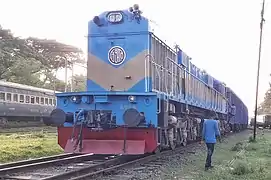 | |
| 6600 | BEP-32 | Progress Rail | GT42AC | 40 | 6601–6640 | On order | 3250 | ? | ? | |
| 7000 | BHZ-5 | Ganz-MÁVAG | DHM 9 | 20 | 7001–7020 | 1980 | 500 | 60 | ? |  |
Preserved diesel locomotives
| Gauge | Class
series |
Loco
no. |
Builder | Build
no. |
Transmission | Location |
|---|---|---|---|---|---|---|
| Metre gauge | 2000 | 2000 | GMD | A443 | Diesel-electric | Pahartali Diesel Shop, Chittagong |
| 3300 | 3309 | Ganz-MÁVAG | ? | Diesel-hydraulic | Central Locomotive Workshop, Dinajpur | |
| 3332 | ? | Saidpur railway workshop, Nilphamari |
Narrow-gauge diesel locomotives
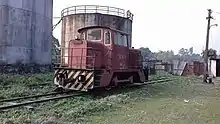
There existed some narrow-gauge diesel locos in Bangladesh. They might be used for industrial purpose, but little is known about their specifications. At least three of them can be found abandoned at various locations around Bangladesh.
Railcars
There used to run some meter-gauge diesel railcars in Bangladesh around the 1980's. But they were active for a short period of time and all of them went off from service. Some railcars were converted to standard passenger coaches and are used on some trains, notably the Chittagong University shuttle trains.
Multiple unit
.jpg.webp)
Meter-gauge Diesel-electric Multiple Unit (DEMU) service were introduced in Bangladesh on May 25, 2013 for short-distance travel. These DEMUs usually are operated on various short-routes including the Chittagong Circular Railway.[13] 20 sets of DEMU were imported which were manufactured by Chinese company "CNR Tangshan". Each set contains 3 coaches which can carry 300 passengers at a time. The power of each set is 800 hp and can go at a speed of 60 km/h maximum.
Besides DEMU, Electric multiple unit (EMU) are supposed to be used on Dhaka Metro Rail, Dhaka Subway and Dhaka–Chittagong high-speed railway.
Locomotive turntables
To change the direction of locos, there exist 12 turntables in Bangladesh. As of 2020, 8 of them are active while the rest 4 are inactive.
- Akhaura, Brahmanbaria
- Bonarpara, Saghata, Gaibandha
- CGPY, Chittagong (Inactive)
- Kamalapur railway station, Dhaka
- Kewatkhali, Mymensingh
- Kulaura, Moulvibazar
- Laksham, Cumilla
- Lalmanirhat (Inactive)
- Noakhali (Inactive)
- Pahartali , Chittagong
- Parbatipur, Dinajpur
- Sylhet
Locomotive workshops and loco sheds
In Bangladesh, there are four workshops for the maintenance and repairing of locomotives:
| Name | Location | Locomotive type |
|---|---|---|
| Central Locomotive Workshop | Parbatipur, Dinajpur | Meter-gauge and broad-gauge |
| Dhaka Diesel Shop | Kamalapur, Dhaka | Meter-gauge |
| Pahartali Diesel Shop | Pahartali, Chittagong | Meter-gauge |
| Parbatipur Diesel Shop | Parbatipur, Dinajpur | Meter-gauge and broad-gauge |
Among them, heavy repairs are done in Central Locomotive Workshop. For the rest three, general maintenance and repairing works are done. Locomotives in excess of 30 years old are considered by Bangladesh Railway as beyond their accountancy and due for replacement.[3]
There are various loco sheds in Bangladesh.
| Name | Location | Status |
|---|---|---|
| Akhaura | Akhaura, Brahmanbaria | Active |
| Bhairab Bazar | Bhairab, Kishoreganj | Inactive |
| Bonarpara | Bonarpara, Saghata, Gaibandha | Active |
| CGPY | Chattogram | Active |
| Dewanganj Bazar | Dewanganj, Jamalpur | Active |
| Fulbaria[14] | Fulbaria, Dhaka | Inactive |
| Ishwardi | Ishwardi, Pabna | Active |
| Kamalapur | Kamalapur railway station, Dhaka | Active |
| Kewatkhali | Mymensingh | Active |
| Khulna | Khulna | Active |
| Kulaura | Kulaura, Moulvibazar | Active |
| Laksham | Laksham, Cumilla | Active |
| Lalmanirhat | Lalmanirhat | Active |
| Pahartali | Pahartali, Chittagong | Active |
| Parbatipur | Parbatipur, Dinajpur | Active |
| Rajbari | Rajbari | Inactive |
| Rupsha East | Rupsha, Khulna | Inactive |
| Santahar | Santahar, Adamdighi, Bogra | Inactive |
| Sarishabari | Sarishabari, Jamalpur | Inactive |
| Sirajganj | Sirajganj | Inactive |
| Sylhet | Sylhet | Active |
See also
References
- "Transportation Survey of East Pakistan, 1961: Detailed report". www.books.google.com. 1961. Retrieved 12 November 2020.
- "মেয়াদোত্তীর্ণ ইঞ্জিনে চলছে ট্রেন | বাংলাদেশ প্রতিদিন". Bangladesh Pratidin. Retrieved 20 April 2020.
- "ANALYSIS OF PROBLEMS" (PDF). Bangladesh Railway. Retrieved 27 November 2020.
- admin (28 August 2012). "DLW bags order for 16 locomotives from Bangladesh Railways". Global Rail News. Archived from the original on 28 August 2017. Retrieved 28 August 2017.
- "Bangladesh Railway orders Progress Rail locomotives". International Railway Journal. 15 January 2019. Retrieved 31 August 2020.
- "Bangladesh taps Progress Rail for GT Series power". Railway Age. 7 February 2019. Retrieved 20 April 2020.
- "Railway - Banglapedia". en.banglapedia.org. Retrieved 20 April 2020.
- Strack, Don. "GENERAL MOTORS DIESEL". utahrails.net. Retrieved 20 April 2020.
- "Old Time Trains". www.trainweb.org. Retrieved 20 April 2020.
- "Preserved Steam Locomotives in Bangladesh". Internationalsteam.co.uk. Retrieved 28 August 2017.
- "Transportation Survey of East Pakistan, 1961: Detailed report". www.books.google.com. 1961. Retrieved 12 November 2020.
- "Steam Locomotive Information". www.steamlocomotive.info. Retrieved 25 September 2020.
- "DEMU trains begin debut run in Ctg". Bdnews24.com. Retrieved 26 May 2013.
- "A quiet masterpiece that serves as Dhaka's gateway". The Daily Star. 24 July 2017. Retrieved 5 November 2020.
External links
 Media related to Locomotives of Bangladesh at Wikimedia Commons
Media related to Locomotives of Bangladesh at Wikimedia Commons- Bangladesh Railway's official website